At first sight, time lapse photography is easy. You can do a time lapse on a smart phone over the course of a few hours, or over a few days using a GoPro. However, a multi-year time lapse throws up a whole new set of problems.
Click above to play the the full multi-year time lapse video. Click below to read more. Please comment and/ or follow me on the social media channel of your choice by clicking on the relevant icon to the right.
Background and Structure of this Post
The client is W.G. Carter, a high-end builder of bespoke luxury homes and “Grand Designs” style renovations. I have done a number of photography projects for W.G. Carter, including images of past projects (for use on their website and display in their offices), a large corporate shoot including all staff and about 50 liveried vehicles and work in an Oxford college. In fact they were my first commercial assignment, see my post: “Learning Architectural Photography“.
W.G. Carter’s Managing Director was keen for me to do a time lapse of a large and complex private swimming pool development. I was initially reluctant as this is a specialist area and one in which I had no expertise. However, as I looked into it, I had an idea that I thought was worth a try.
This post is divided into the following sections:
- The Brief
- Why Multi-Year Time Lapse Photography is More Difficult
- General Approach
- Problems Encountered Along the Way
- Refining the Finished Video.
The Brief
W.G. Carter’s brief, as part of a country house refitment, was to build a swimming pool complex buried within the hill close to the main house. Stage one was extensive excavation; stage two building; stage three landscaping to make the whole environment look good again. Swimming pools construction is apparently notoriously difficult and this project promised to be additionally challenging, and consequently prestigious, even for W.G. Carter.
Originally the project was expected to last for 18 months.
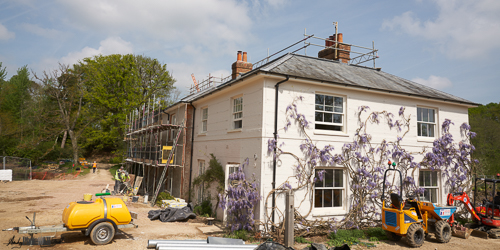
Why Multi-Year Time Lapse Photography is More Difficult
Issues that become dominant as the duration of time lapse extends:
- weather sealing
- continuity of power
- equipment security, i.e., ensuring that the camera isn’t nicked
- image security, i.e., reliability of memory cards.
The last point was of particular concern as my biggest fear was getting to the end of the project to find that no images had been recorded.
General Approach
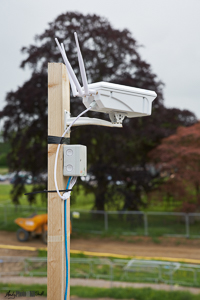
My idea was to use a high definition security video surveillance camera with built in mobile communications. The camera is programmed to take a shot every 2 minutes and transmit this to our secure FTP file server, which is then backed up to my NAS drive. The camera was positioned on the roof of the Manor House, overlooking the site of the pool development.
Anticipated advantages:
- the camera is designed to work outside, for long periods of time without maintenance
- the usual source of power is a 12v external power supply
- it is unlikely that anyone will try and steal what is obviously a CCTV camera, from the roof of a large house
- images are held in triplicate on the camera’s memory card, the remote file server and my NAS drive
- we were able to set alerts such that if the system failed to send and images for a 5 minute period, we were send an alarm email.
One frame per day for 18 months would yield approximately 550 frames which at 25 frames/ second is 22 seconds of footage
Problems Encountered Along the Way
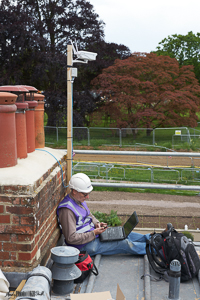
Power to the camera
Initially power to the camera was provided via a 30m length of CAT 4 networking cable. Vast lengths of this were being installed in the manor house so finding us a spare 30-40m was no problem. All seemed to work OK with the power supply down in the services room and the camera 30m away on the roof. However, the system did seem at times a little fragile and unreliable, which we later diagnosed as being due to the fact that 12v into the CAT 5 cable delivers much less 30m away. So we swapped out the original power supply in favour of a 16v supply and a clever box at the camera end which converted whatever voltage came out of the cable down to 12v. The camera was happy and worked faultlessly for the duration of the project.
Image right shows my collaborator, Andy Preston, testing the networking that connected the camera to the FTP server on our website.
Site Support
Whilst everybody thought the idea of a time lapse documenting the build was quite cool, many of the on-site staff had the impression that this would result in a speeded up video of their every move and were not that keen on being spied on. Early in the project we found that our power supply had been accidentally unplugged in favour of some other equipment. This is where our automated alarm system kicked in and enabled me to phone the site manager, within minutes of this happening, and ask him to investigate.
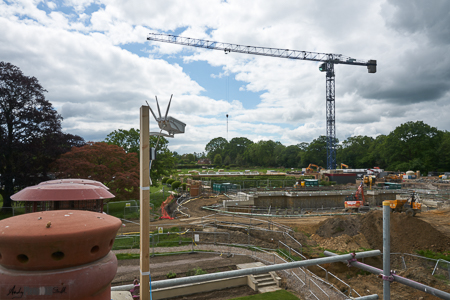
Issues beyond our control
The whole of the O2 mobile service was down for a day. Although this initially caused us to panic, we had only lost 1 day’s worth of footage, i.e., one frame, and if we were really that worried, we had it on the memory card.
Our FTP server, hosted by a premier third party provider, got hacked. We had copies of everything on my NAS drive which we immediately backed up to a remote NAS. Then redirected newly captured images to the remote NAS. In this way the remote NAS, directly under our control, replaced the third party platform, whilst my NAS remained the daily backup. We have found no reason to go back to the third party server as the dual NAS system worked until the end of the project.
Refining the Finished Video
Selecting the daily frame
Although we only need one frame per day, the issue is: which frame do we choose to provide the smoothest and most attractive video?
Initially we thought we would choose the same time every day as this would mean the sun was always in the same position. However, we found that better results were obtained by selecting the image with the largest file size as this corresponded to the most detailed image with the most contrast and colour.
Inter-frame movement
One problem with the camera was that its mounting to roof via a wooden post was less than perfectly stable, particularly in high wind, and allowed a few pixels of movement between shots. Usually not that much, but enough to make the image look a bit juddery.
My initial idea to fix this problem was to write a Photoshop action in the form of a Droplet and align each frame with the previously aligned frame. Simple enough principle, however Photoshop really doesn’t like saving a document twice, one changing with the name of the image and stored in the specified destination, and the other just updating the “Reference” image. This required a spot of JavaScript.
However, a much better solution was found in the form of the free version of the DaVinci video editing software. This had image stabilisation built in and seemed to do a competent job, although the aligned frames gradually became smaller, giving the effect that the camera was zooming. Then it recovered gradually but gave illusion that the viewpoint was moving. Strange and unexpected but both I and the client thought this added to rather than detracted from the viewing experience. The software also allowed us to add a soundtrack – “Flight of the Bumblebee” by Rimsky Korsakov
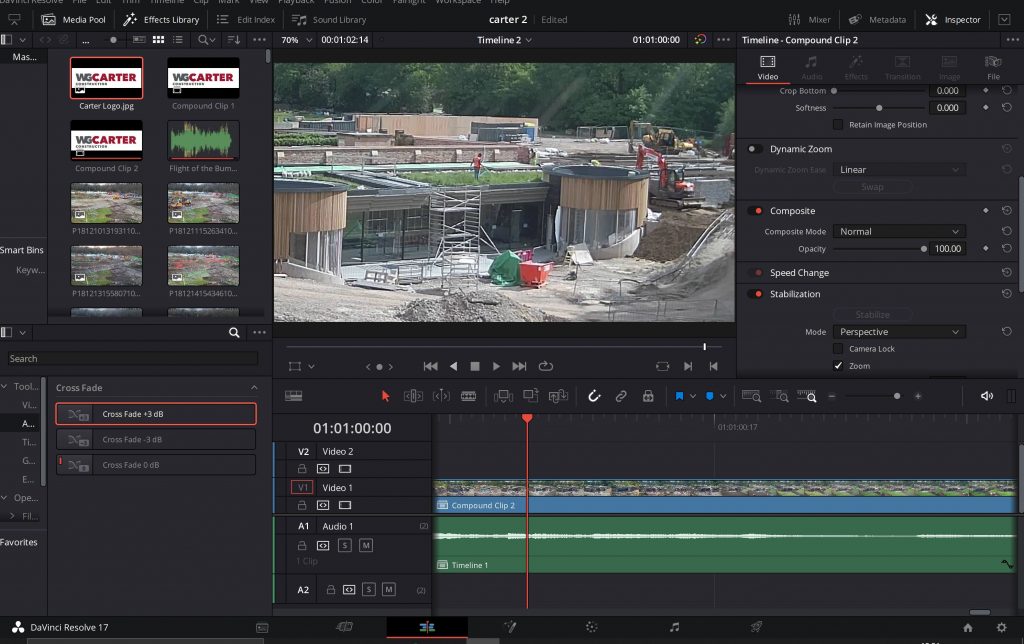
Most importantly, the management at WG Carter were happy.
Very interesting! Your commentary indicates how much more complex the job appears than at first sight – 3 years though – no wonder Crossrail is taking so long….some points if I may:
– there is a mild stroboscopic effect produced – is it possible to minimise this further?
– it’s not easy to see that it’s a swimming pool – or how it orientates to the main house
– were there any longer gaps in construction or was it a continuous process
Best K
Hi Kevin,
Thank you for commenting on this. I have rebuilt the video and set the Timelapse to the Flight of the Bumblebee by Rimsky-Korsakov. The flickering is still there but is somehow more bearable when accompanied by an appropriate tune.
I agree that there is no time when it looks like a swimming pool. I too was quite surprised by this.
Now need to make the new video load faster in the webpage …